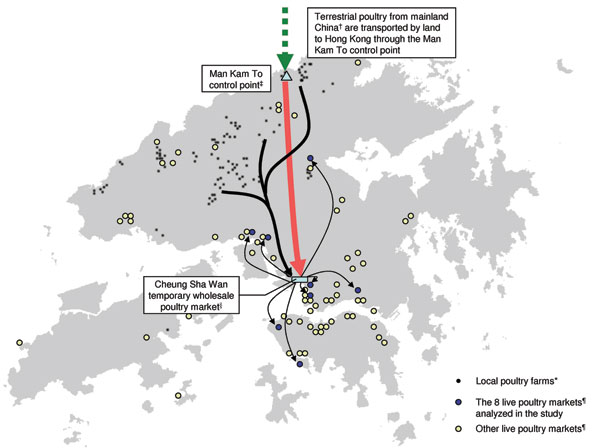Volume 13, Number 9—September 2007
Research
Effect of Interventions on Influenza A (H9N2) Isolation in Hong Kong’s Live Poultry Markets, 1999–2005
Figure 1

Figure 1. Supply chain of live terrestrial poultry in Hong Kong. *During the study period, 110–140 local poultry farms were registered in Hong Kong with ≈2 million chickens. Weekly inspection, flock laboratory surveillance, and universal vaccination of chickens with inactivated influenza (H5N2) vaccine have been routine since June 1, 2003. All terrestrial poultry (e.g., chickens and minor poultry such as quail, pheasant, chukar, guinea fowl) are transported to Cheung Sha Wan Temporary Wholesale Poultry Market by trucks before redistribution to live poultry markets (LPMs). *Ducks and geese were imported by sea to a separate wholesale poultry market (not shown in figure), where they were centrally slaughtered, and the chilled carcasses were sold to market. †Approximately 100 registered mainland farms supplied ≈40% of live chickens in 2006. Since January 15, 2004, all such birds have been vaccinated against H5 influenza. They are transported by trucks inside labeled cages to Man Kam To Control Point. ‡Imported birds must be accompanied by valid veterinary health certificates issued by a recognized veterinary authority. Samples are also taken for laboratory testing. The birds are then transported to Cheung Sha Wan Temporary Wholesale Poultry Market by lorry in which water and land birds are segregated. §Birds are transported to LPMs after confirmation of negative test results from the laboratory. Regular laboratory surveillance and monthly rest-days in the wholesale market synchronized with those in LPMs are also routinely carried out. Birds are distributed to live poultry stalls and kept in cages made of stainless steel or nonabsorbent materials. A ban of live waterfowl sales had been imposed since December 1997. Since December 2001, quails had also been removed from being sold alongside chickens and by March 2002, live quails were completely banned in LPMs. There were 60–80 LPMs (light circles) in Hong Kong; 8 of these (dark circles) were analyzed in this study.